Pulled Thread Embroidery, a timeless needlework art, transforms fabric into intricate, openwork masterpieces.
This delicate technique involves manipulating fabric threads, creating a play of voids and textures.
Utilizing even-weave fabrics like linen or cotton, practitioners skillfully pull or tighten threads to craft geometric patterns or lattice designs, revealing the beauty of the fabric itself.
Unlike traditional embroidery, pulled threadwork doesn’t add stitches but selectively alters the fabric’s structure.
Precision is paramount as artisans employ techniques such as hemstitching and cutwork. The result is an elegant tapestry of carefully manipulated threads, a testament to the craftsmanship and creativity intrinsic to pulled thread embroidery.
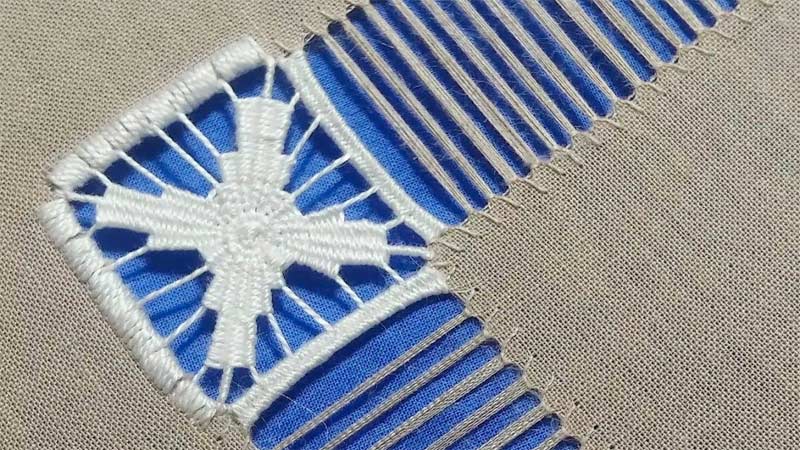
What Does Pulling Thread Mean?
Pulled thread embroidery is a delicate and intricate needlework technique that creates openwork patterns by manipulating and pulling threads in woven fabric.
Unlike traditional embroidery, pulled thread work doesn’t rely on adding stitches but rather focuses on selectively removing or tightening threads to form unique designs.
Commonly used on linen or other even-weave fabrics, this art form showcases the beauty of the fabric itself.
The process involves carefully pulling threads aside or tightening them to create latticework, geometric shapes, or textured patterns.
Needleworkers often employ techniques like hemstitching, drawn fabric, and cutwork to achieve various effects. Pulled thread embroidery requires precision, patience, and a keen eye for detail.
The resulting pieces exude timeless elegance, making this technique famous for creating delicate table linens, intricate doilies, and heirloom-quality textiles that testify to the craftsmanship and artistry of this unique form of needlework.
How to Do Pulled Thread Embroidery?
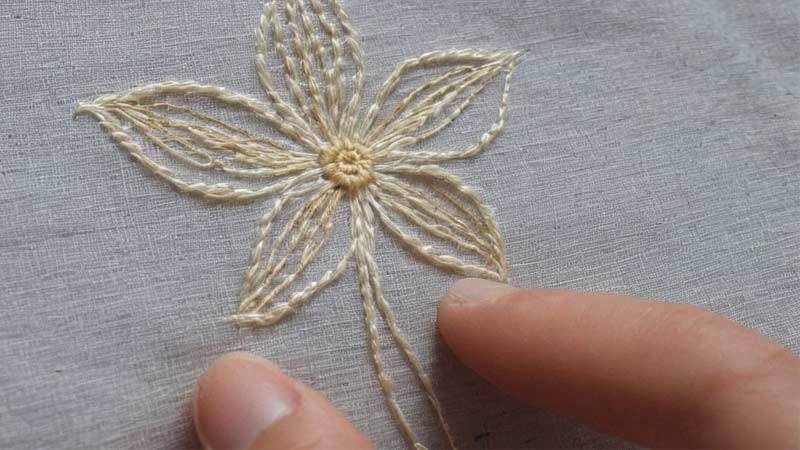
Pulled thread embroidery is a captivating needlework technique that manipulates fabric threads to create openwork designs.
To embark on this art form, follow these basic steps:
Choose the Right Fabric
When selecting fabric for pulled thread embroidery, prioritize even-weave options like linen or cotton. These fabrics provide a consistent grid, facilitating easier thread manipulation.
The even weave ensures that the tension remains uniform throughout the embroidery process, creating a polished and professional appearance in the final piece.
Be mindful of the fabric’s texture and weight, as it can influence the overall aesthetic and feel of the completed work.
Select Suitable Threads
Opt for fine threads like cotton or linen embroidery floss to execute pulled thread embroidery effectively. These threads should harmonize with the chosen fabric in terms of color and texture.
Fine threads not only enhance the delicacy of the design but also make manipulation more manageable.
Consider experimenting with various thread colors to achieve subtle contrasts or vibrant combinations that enhance the visual appeal of your embroidery.
Prepare the Fabric
Before delving into the stitching process, properly prepare the fabric. Secure it in an embroidery hoop to maintain consistent tension, which is essential for precise thread manipulation.
A taut fabric surface ensures the pulled thread techniques create the desired effects. Additionally, start with a clean and well-pressed fabric, eliminating any wrinkles or imperfections that could affect the finished embroidery’s overall quality.
Plan Your Design
The success of pulled thread embroidery relies on thoughtful planning. Choose a design that complements the nature of the technique, often featuring geometric shapes or lattice patterns.
Sketch the design lightly on the fabric using a pencil or a water-soluble fabric marker. This preliminary step helps guide your stitching and ensures the final result aligns with your creative vision.
Start Stitching
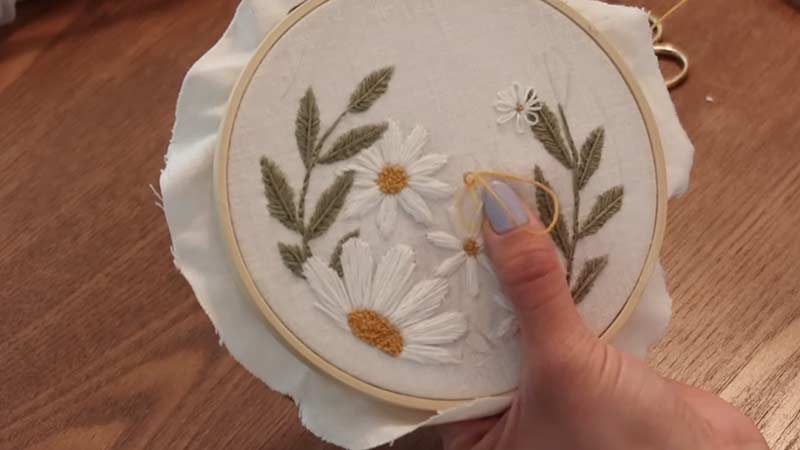
Dive into the pulled thread embroidery world by employing techniques such as hemstitching, drawn fabric, or cutwork.
Use a sharp needle to manipulate the fabric threads carefully according to your predetermined design.
Exercise patience and precision during this phase, as pulled thread embroidery’s beauty lies in the manipulated threads’ intricacy.
Take time to refine your stitches and experiment with different techniques to achieve the desired visual effects in your embroidery.
Maintain Consistent Tension
Thread tension plays a pivotal role in the success of pulled thread embroidery. Vigilantly monitor and adjust the tension as needed to ensure uniformity in the fabric’s appearance.
Consistency in tension is essential for creating a polished and professional-looking piece. A balanced tension contributes to the stitches’ precision and enhances the embroidered design’s overall visual appeal.
Regularly check the tautness of the fabric in the embroidery hoop, making necessary adjustments to achieve the desired results.
Secure Ends
To safeguard your pulled thread embroidery from unraveling, diligently finish each manipulation by securing the ends with tiny, inconspicuous stitches.
This step contributes to the piece’s longevity and adds a refined touch to the overall craftsmanship.
By preventing threads from loosening over time, you ensure that your intricate embroidery remains intact, allowing viewers to appreciate the meticulous details without concern for unraveling or fraying.
Experiment and Refine
Pulled thread embroidery offers a canvas for creativity and exploration. Embrace the opportunity to experiment with different techniques and thread tensions.
Through practice, refine your skills and discover the unique effects achievable with various stitches and manipulations.
Embracing experimentation is critical to developing your style within pulled thread embroidery.
Don’t hesitate to explore new patterns, combinations, and applications, as the art form encourages continuous refinement and innovation.
Finishing Touches
Once your pulled thread embroidery design is complete, apply finishing touches to elevate the presentation of your work.
Press the finished piece with a warm iron to smooth any wrinkles and showcase the intricate details. Consider framing your masterpiece to protect it and showcase it as standalone art.
Alternatively, incorporate the finished embroidery into a larger project, such as a quilt or garment, allowing your pulled thread creation to become a captivating focal point within a broader artistic context.
What Are Popular Designs in Pulled Thread Embroidery?
Pulled thread embroidery encompasses various designs, each showcasing the artistry of manipulating fabric threads.
Some popular designs include:
Lattice Patterns
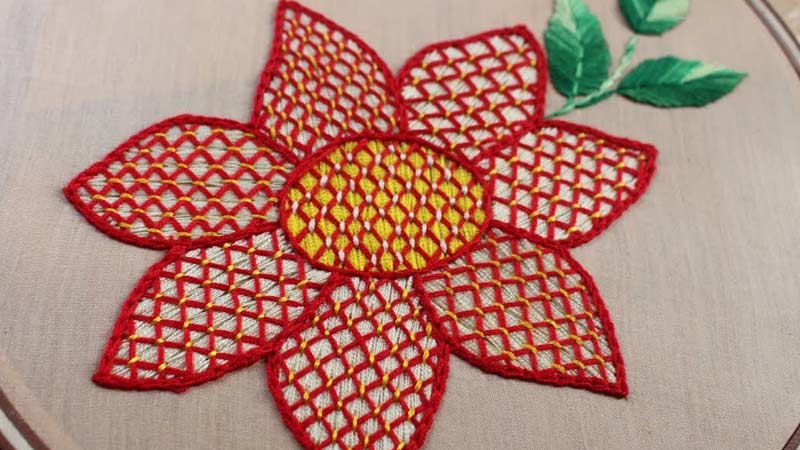
Lattice patterns in pulled thread embroidery showcase a symphony of intersecting threads, creating a mesmerizing grid-like structure.
The intricate nature of these patterns requires meticulous thread manipulation, where specific threads are delicately pulled or tightened.
Lattice designs often evoke a sense of delicacy and sophistication, making them a popular choice for enhancing the visual appeal of various textile projects.
The interplay of pulled threads results in a subtle texture that adds depth to the fabric, contributing to the overall elegance of the embroidered piece.
Geometric Shapes
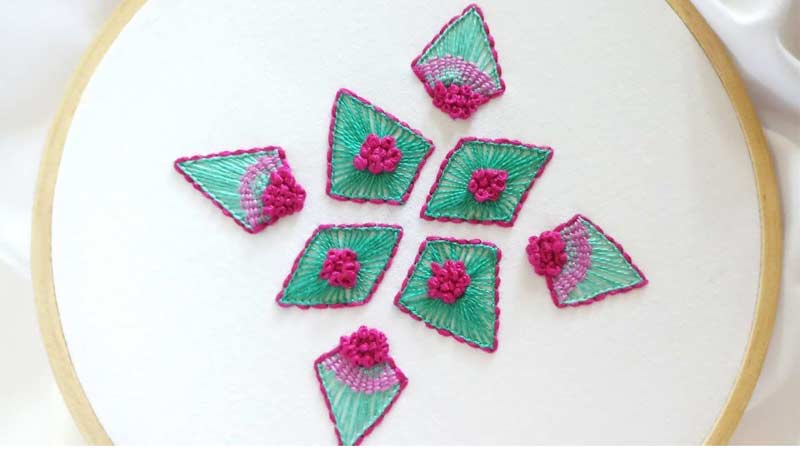
Pulled thread embroidery’s charm lies in its ability to transform fabric into a canvas of precision and simplicity.
Geometric shapes like squares, triangles, and diamonds take center stage in this art form, demonstrating the artisan’s skill and attention to detail.
The precision required to achieve these shapes highlights the mastery of the craft, creating visually striking patterns that can range from minimalist elegance to more intricate and elaborate designs.
Geometric shapes in pulled thread embroidery provide a timeless aesthetic that appeals to both traditional and contemporary tastes.
Hemstitching
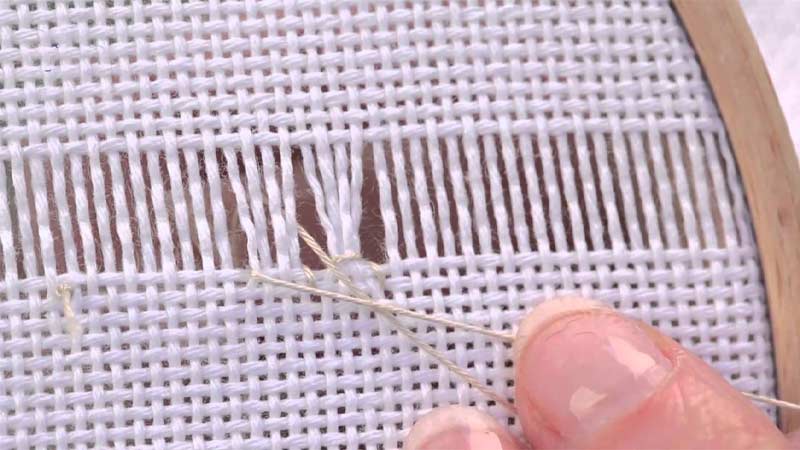
Hemstitching is a quintessential pulled thread technique that imparts a classic touch to the embroidered fabric.
In this method, groups of parallel threads are carefully pulled and then secured with stitches, creating a decorative border along the fabric’s edges.
This delicate yet impactful embellishment not only adds visual interest but also serves a functional purpose by reinforcing the fabric’s perimeter.
Hemstitched edges elevate the overall aesthetic of the piece, offering a timeless and refined finish that complements a variety of projects, from handkerchiefs to table linens.
Drawn Fabric
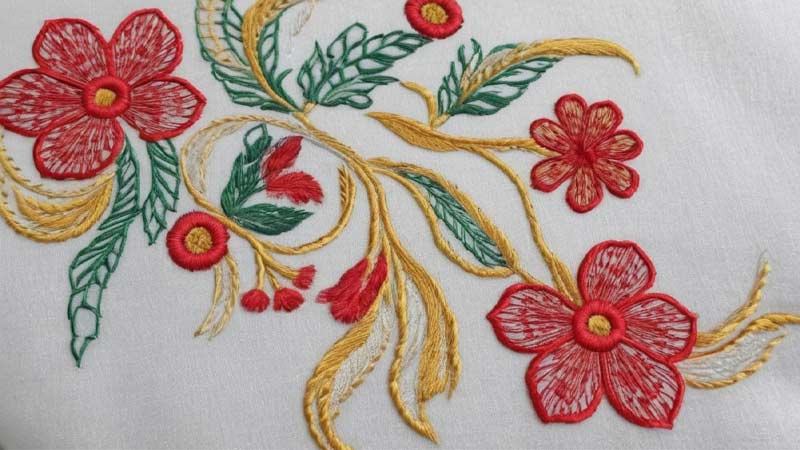
Drawn fabric techniques in pulled thread embroidery involve selectively removing threads to craft open spaces, resulting in designs that exude an airy and lace-like quality.
This method imparts an ethereal beauty to the fabric, creating a delicate interplay between filled and open areas.
Artisans strategically choose which threads to pull, allowing for the creation of intricate patterns and textures.
Drawn fabric designs are versatile, ranging from subtle and understated to more elaborate and ornate, making them well-suited for a variety of applications, including decorative linens and clothing embellishments.
Cutwork
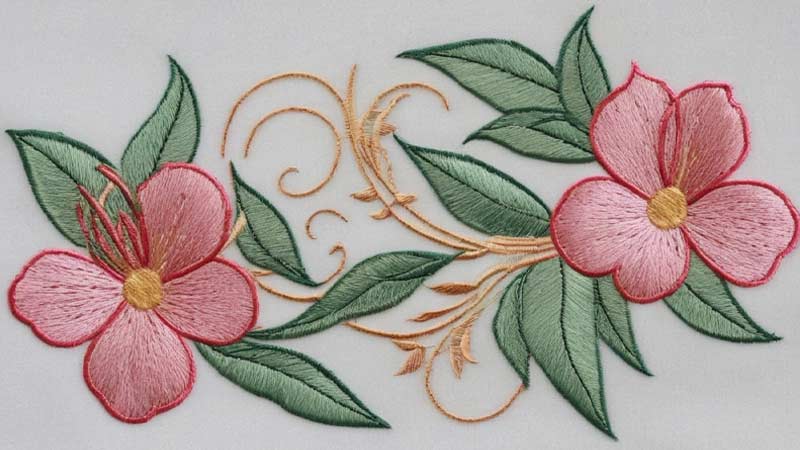
Pulled thread embroidery takes on a more intricate and dimensional character with the incorporation of cutwork. This technique involves skillfully cutting and removing fabric threads to form elaborate patterns.
Cutwork adds a layer of texture and depth to the design, making it a favored choice for creating visually striking and sophisticated pieces.
From intricate filigree to bold and geometric motifs, cutwork in pulled thread embroidery allows artisans to push the boundaries of creativity, resulting in unique and captivating works of textile art.
Eyelets
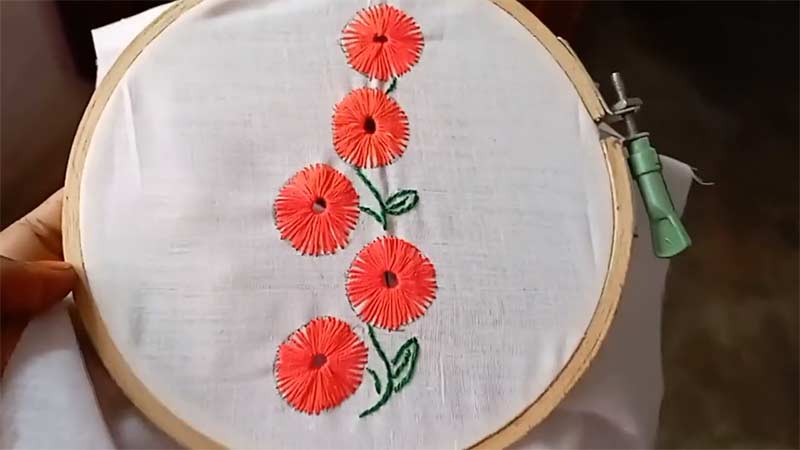
The addition of eyelets in pulled thread embroidery introduces a charming and dainty element to the design.
Artisans create small openings by manipulating threads, forming patterns that add a whimsical touch to the fabric.
These eyelets can be arranged in various configurations, from simple geometric arrangements to more intricate and elaborate designs.
Eyelets provide a delicate contrast to the pulled threads, creating a harmonious balance between filled and open spaces.
This technique is often used to enhance the overall aesthetic of garments, accessories, and decorative textiles.
Floral Motifs
While pulled thread embroidery is often associated with geometric precision, floral motifs bring a touch of nature-inspired grace to this intricate art form.
Artisans manipulate threads to create delicate flowers, vines, and leaves, infusing the fabric with organic beauty.
The combination of precise thread manipulation and creative freedom allows for the crafting of intricate floral patterns that range from subtle and elegant to bold and dramatic.
Floral motifs in pulled thread embroidery offer a versatile and timeless design element, making them a popular choice for embellishing a variety of textile projects.
Sampler Patterns
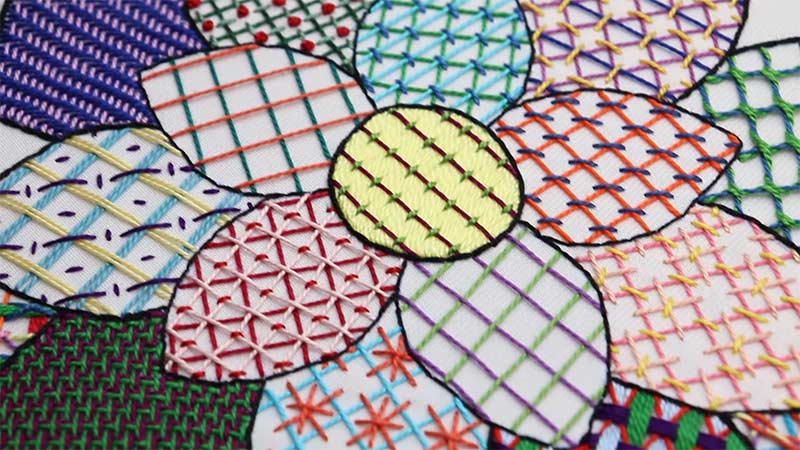
Pull thread samplers serve as dynamic canvases for showcasing the diverse range of techniques within pulled thread embroidery.
These comprehensive pieces often feature a combination of lattice patterns, geometric shapes, floral motifs, and other intricate designs.
Samplers serve both as practice projects for artisans to refine their skills and as visual references for exploring the possibilities within pulled thread embroidery.
The eclectic mix of patterns within a sampler allows embroiderers to experiment with different techniques and create a stunning showcase of the craft’s versatility and artistic expression.
FAQs
What fabrics are suitable for pulled thread embroidery?
Even-weave fabrics like linen or cotton are ideal for pulled thread embroidery. These fabrics provide a consistent grid, making it easier to manipulate threads.
The even weave ensures uniform tension throughout the embroidery process.
How do you secure thread ends in pulled thread embroidery?
To prevent unraveling, each thread manipulation should be finished by securing the ends with small stitches.
This step contributes to the longevity of the embroidery and ensures the threads remain intact over time.
Can pulled thread embroidery be incorporated into larger projects?
Yes, pulled thread embroidery can be integrated into various projects, such as quilts, garments, or framed pieces.
To Recap
Pulled thread embroidery stands as a testament to the meticulous artistry and creative finesse inherent in needlework.
This timeless technique transforms even-weave fabrics into exquisite tapestries, unveiling intricate designs through the manipulation of threads.
From the delicate allure of lattice patterns to the precision of geometric shapes, pulled thread embroidery is a canvas for both tradition and innovation.
Techniques such as hemstitching, drawn fabric, cutwork, and the inclusion of eyelets add layers of complexity, while floral motifs bring a touch of nature’s grace.
Pulled thread embroidery invites artisans to explore, experiment, and master a craft that transcends time, resulting in textile masterpieces that captivate with their beauty and sophistication.
—————————————————————
Meta Description:
Explore the art of Pulled Thread Embroidery, a timeless needlework technique transforming fabrics into intricate masterpieces. Learn how to create geometric patterns, floral motifs, and more.
Leave a Reply